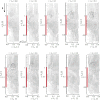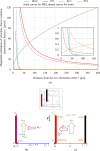Development of three-dimensional integrated microchannel-electrode system to understand the particles' movement with electrokinetics
- PMID: 27042247
- PMCID: PMC4798993
- DOI: 10.1063/1.4943859
Development of three-dimensional integrated microchannel-electrode system to understand the particles' movement with electrokinetics
Abstract
An optical transparent 3-D Integrated Microchannel-Electrode System (3-DIMES) has been developed to understand the particles' movement with electrokinetics in the microchannel. In this system, 40 multilayered electrodes are embedded at the 2 opposite sides along the 5 square cross-sections of the microchannel by using Micro Electro-Mechanical Systems technology in order to achieve the optical transparency at the other 2 opposite sides. The concept of the 3-DIMES is that the particles are driven by electrokinetic forces which are dielectrophoretic force, thermal buoyancy, electrothermal force, and electroosmotic force in a three-dimensional scope by selecting the excitation multilayered electrodes. As a first step to understand the particles' movement driven by electrokinetic forces in high conductive fluid (phosphate buffer saline (PBS)) with the 3-DIMES, the velocities of particles' movement with one pair of the electrodes are measured three dimensionally by Particle Image Velocimetry technique in PBS; meanwhile, low conductive fluid (deionized water) is used as a reference. Then, the particles' movement driven by the electrokinetic forces is discussed theoretically to estimate dominant forces exerting on the particles. Finally, from the theoretical estimation, the particles' movement mainly results from the dominant forces which are thermal buoyancy and electrothermal force, while the velocity vortex formed at the 2 edges of the electrodes is because of the electroosmotic force. The conclusions suggest that the 3-DIMES with PBS as high conductive fluid helps to understand the three-dimensional advantageous flow structures for cell manipulation in biomedical applications.
Figures









Similar articles
-
Characterization of electrokinetic mobility of microparticles in order to improve dielectrophoretic concentration.Anal Bioanal Chem. 2009 May;394(1):293-302. doi: 10.1007/s00216-009-2626-y. Epub 2009 Feb 4. Anal Bioanal Chem. 2009. PMID: 19190896
-
Numerical Study of Particle-Fluid Flow Under AC Electrokinetics in Electrode-Multilayered Microfluidic Device.IEEE Trans Biomed Eng. 2019 Feb;66(2):453-463. doi: 10.1109/TBME.2018.2849004. Epub 2018 Jun 19. IEEE Trans Biomed Eng. 2019. PMID: 29993454
-
Distinct Motion of GFP-Tagged Histone Expressing Cells Under AC Electrokinetics in Electrode-Multilayered Microfluidic Device.IEEE Trans Biomed Circuits Syst. 2017 Dec;11(6):1450-1458. doi: 10.1109/TBCAS.2017.2729584. Epub 2017 Aug 14. IEEE Trans Biomed Circuits Syst. 2017. PMID: 28809711
-
Recent advances in direct current electrokinetic manipulation of particles for microfluidic applications.Electrophoresis. 2019 Sep;40(18-19):2484-2513. doi: 10.1002/elps.201900048. Epub 2019 Mar 8. Electrophoresis. 2019. PMID: 30816561 Review.
-
Electric field-induced effects on neuronal cell biology accompanying dielectrophoretic trapping.Adv Anat Embryol Cell Biol. 2003;173:III-IX, 1-77. doi: 10.1007/978-3-642-55469-8. Adv Anat Embryol Cell Biol. 2003. PMID: 12901336 Review.
Cited by
-
Investigation of particle inertial migration in high particle concentration suspension flow by multi-electrodes sensing and Eulerian-Lagrangian simulation in a square microchannel.Biomicrofluidics. 2016 Apr 12;10(2):024120. doi: 10.1063/1.4946012. eCollection 2016 Mar. Biomicrofluidics. 2016. PMID: 27158288 Free PMC article.
-
Concentration profiles of ions and particles under hydrodynamic focusing in Y-shaped square microchannel.Sci Rep. 2021 Jan 28;11(1):2585. doi: 10.1038/s41598-021-82259-4. Sci Rep. 2021. PMID: 33510410 Free PMC article.
-
A Continuous Cell Separation and Collection Approach on a Microfilter and Negative Dielectrophoresis Combined Chip.Micromachines (Basel). 2020 Nov 26;11(12):1037. doi: 10.3390/mi11121037. Micromachines (Basel). 2020. PMID: 33255917 Free PMC article.
References
-
- Hicok K. and Hedrick M., in Adipose-Derived Stem Cells, edited by Gimble J. M. and Bunnell B. A. ( Humana Press, 2011), Vol. 702, Chap. 8, pp. 87–105.
-
- Givan A., in Flow Cytometry Protocols, edited by Hawley T. S. and Hawley R. G. ( Humana Press, 2011), Vol. 699, Chap. 1, pp. 1–29.
LinkOut - more resources
Full Text Sources
Other Literature Sources
Research Materials
